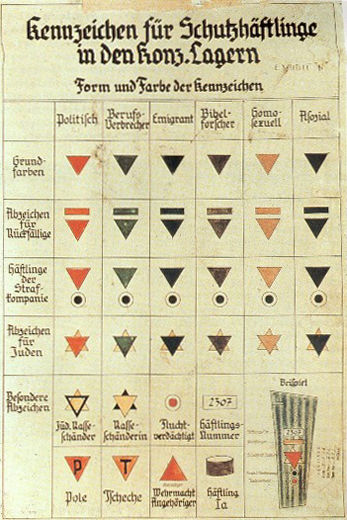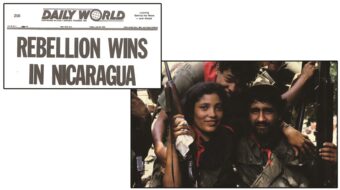
On this date in 1976, speakers at a public program in Hartford, Conn., told the history and paid homage to the homosexuals exterminated in the Nazi concentration and labor camps.
A West Hartford resident in the 1970s, I noticed that local Jewish and human rights activists were planning to build a Holocaust memorial, a “Mandala,” in the city. As an activist, I saw an opportunity for inclusion of the homosexuals, about whom testimony and scholarship had begun to emerge. According to available sources then, some 250,000 homosexuals had been killed, although later historians have greatly reduced that estimate to perhaps 10,000.
In a December 1975 letter to the West Hartford Human Rights Commission (WHHRC), I offered to show them my research, but was summarily dismissed. It appeared to me that these prominent citizens were themselves perpetuating one of society’s oldest and most deeply embedded prejudices – against gay people – while calling public attention to the racism, bigotry, and genocide of the Holocaust.
Leaders of the local Metropolitan Community Church (MCC), a Christian communion oriented toward gays and lesbians, joined me at the WHHRC Holocaust memorial meeting on April 27, 1976, handing out informative leaflets to the public, since no one would talk with us in person or allow us onto their program. We noted the irony that Governor Ella T. Grasso gave the opening welcome to the meeting – she who for years had openly voiced concern about homosexual schoolteachers in a blatant attempt to quash the first legislative attempts in Connecticut to pass anti-discrimination laws. We were outsiders to history.
The neglect was willful. The WHHRC program did recognize Christian victims of the Holocaust, so awareness of other-than-Jews had broken through. But no homosexuals, please, despite the stirring call to action: “We have stood by and watched Blacks being lynched, American-born Japanese being interned, Indians being deprived of their rights…when will it all end? Only when we as individuals take a firm stand and act positively against any form of human degradation.”
In response to the resounding silence we got from the good folks of West Hartford, MCC and “None of the Above” – a weekly show which I co-produced on WWUH, the community radio station of the University of Hartford – planned an evening called “The Pink Triangle: A Gay Community Holocaust Memorial” at the Unitarian Church in Hartford, on Thursday, June 24, 1976, during Gay Pride Week. After an organ prelude, a formal welcome and an invocation, I delivered the main address about this untold story, drawn from a number of published sources, some in German, that we cited in the printed program. “History is a living lesson,” I reminded our audience. “We are now saying – along with the Jews of the world – never again!”
The audience of about 50 experienced some nervousness when a television camera appeared – people could lose their jobs!
My partner at the time, Michael Jospe, designed the poster for our program, which depicted a swastika emitting flames that were consuming a pink triangle. Michael was a Jewish South African whose parents had fled from Germany in the 1930s, as Michael himself had left his own native country in the 1960s out of disgust with apartheid.
That day remains one of my proudest: This was the first public recognition anywhere in the world of the experience of homosexual repression and extermination in the Holocaust. Our “None of the Above” collective edited the program for broadcast on August 2.
MCC and I continued to offer to help the Mandala project with fundraising in the gay community and with my research if they would use it. Over the next couple of years I ran into one brick wall of refusal after another. Clergy attacked us as sinful people. The homophobia deeply ingrained in the greater Hartford community illuminated for me how susceptible the “good Germans” could be regarding minority – or let us say, full – human rights.
The story got into local papers, and the Mandala people did not come off well. It seemed like human rights were fine concerning those far away or dead, but we were implicitly challenging complacency and prejudice right here at home.
In the end, the Mandala never got built. Some town body vetoed the project and the whole plan was dropped. Did our campaign for inclusion put the kibosh on it? I have no way to know, but maybe there was some fear that the site would always attract protest, or perhaps vandalism. Perhaps the town decided after all that if the Mandala was meant to serve exclusively Jewish memory, it should be built on private, not public property.
I have remained alert to the issue of broader acknowledgment of loss in the Holocaust. For many years now I have consistently noted that groups other than Jews regularly get named – political resisters, trade unionists, Rom (Gypsies), Jehovah’s Witnesses, and homosexuals – with frequent illustrations of the different colored badges each group was forced to wear, including the Pink Triangle. There are even physical monuments to the homosexuals in places today. Over time, we made our point effectively. I look back with satisfaction on our efforts of those years.
Image: Nazi camp ID-emblems in a 1936 German illustration. “Kennzeichen für Schutzhäftlinge in den Konzentrationslagern” by Unknown – United States Holocaust Museum Washington. Licensed under Public Domain via Wikimedia Commons .












Comments